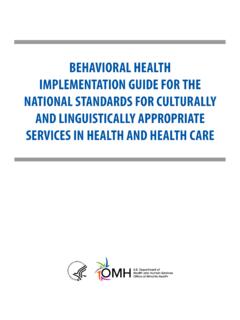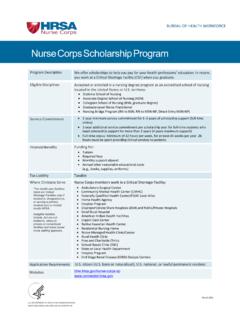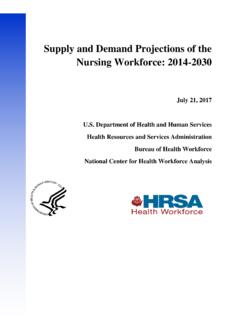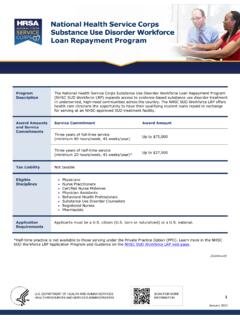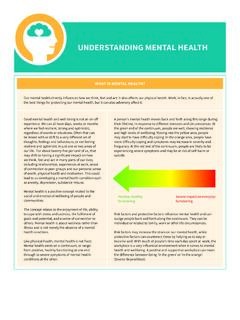Transcription of HHS Action Plan to Reduce Racial and Ethnic Health …
1 HHS Action Plan to Reduce Racial and Ethnic Health disparities A NAtioN free of disparities iN Health ANd Health cAre TABLE OF CONTENTS A Nation Free of disparities in Health and Health Care Introduction and Background .. 1 New Opportunities .. 7 Vision and Purpose .. 11 Overarching Secretarial Priorities .. 12 Goal I: Transform Health Care .. 15 Goal II: Strengthen the Nation s Health and Human Services Infrastructure and workforce .. 19 Goal III: Advance the Health , Safety, and Well-Being of the American People .. 25 Goal IV: Advance Scientific Knowledge and Innovation .. 29 Goal V: Increase Efficiency, Transparency, and Accountability of HHS Programs .. 33 Conclusion .. 35 References .. 36 Appendix A: Provisions of the Affordable Care Act that Address Health disparities .. 39 Appendix B: Key Opportunities to Advance Health Disparity Reduction at HHS .. 42 Appendix C: Key Disparity Measures.
2 44 Appendix D: Acronyms .. 45 1 A Nation Free of disparities in Health and Health Care INTrODuCTION AND BACkgrOuND Introduction and Background It is time to refocus, reinforce, and repeat the message that Health disparities exist and that Health equity benefits everyone. Kathleen G. Sebelius, Secretary, Health & Human Services Medical advances and new technologies have provided people in America with the potential for longer, healthier lives more than ever before. However, persistent and well-documented Health disparities exist between different Racial and Ethnic populations and Health equity remains elusive. Health disparities differences in Health outcomes that are closely linked with social, economic, and environmental disadvantage are often driven by the social conditions in which individuals live, learn, work and play. This document provides a brief overview of Racial and Ethnic Health disparities and unveils a Department of Health and Human Services (HHS) Action Plan to Reduce Racial and Ethnic Health disparities ( HHS disparities Action Plan ).
3 The HHS disparities Action Plan complements the 2011 National Stakeholder Strategy for Achieving Health Equity, a product of the National Partnership for Action ( NPA Stakeholder Strategy ). The NPA Stakeholder Strategy reflects the commitment of thousands of individuals across the country in almost every sector. It resulted from a public-private collaboration that solicited broad community input with the assistance of state and local government and Federal agencies. The NPA Stakeholder Strategy proposes a comprehensive, community-driven approach to Reduce Health disparities in the and achieve Health equity through collaboration and synergy. Now, this first-ever HHS disparities Action Plan and the NPA Stakeholder Strategy can be used together to coordinate Action that will effectively address Racial and Ethnic Health disparities across the country. Furthermore, the HHS disparities Action Plan builds on national Health disparities goals and objectives recently unveiled in Healthy People 2020, and leverages key provisions of the Affordable Care Act and other cutting-edge HHS initiatives.
4 With the HHS disparities Action Plan, the Department commits to continuously assessing the impact of all policies and programs on Racial and Ethnic Health disparities . Furthermore, the Department can now promote integrated approaches, evidence-based programs and best practices to Reduce these disparities . Together, the HHS disparities Action Plan and the NPA Stakeholder Strategy provide strong and visible national direction for leadership among public and private partners. While the Department respects and recognizes the critical roles other Federal departments play in reducing Health disparities , this Action plan focuses on HHS initiatives. 2 A Nation Free of disparities in Health and Health Care INTrODuCTION AND BACkgrOuND Overview of Racial and Ethnic Health disparities The societal burden of Health and Health care disparities in America manifests itself in multiple and major ways. In one stark example, Murray et al show a difference of 33 years between the longest living and shortest living groups in the Another study, The Economic Burden of Health Inequalities in the United States, by the Joint Center for Political and Economic Studies, concludes that the combined costs of Health inequalities and premature death in the United States were $ trillion between 2003 and Such Health disparities arise from both biologic factors and social factors that affect individuals across their lifespan.
5 Regarding the latter, the World Health Organization (WHO) defines these social determinants of Health as the conditions in which people are born, grow, live, work and age that can contribute to or detract from the Health of individuals and Marked difference in social determinants, such as poverty, low socioeconomic status (SES), and lack of access to care, exist along Racial and Ethnic lines. These differences can contribute to poor Health Individuals, families and communities that have systematically experienced social and economic disadvantage face greater obstacles to optimal Health . Characteristics such as race or ethnicity, religion, SES, gender, age, mental Health , disability, sexual orientation or gender identity, geographic location, or other characteristics historically linked to exclusion or discrimination are known to influence Health While this HHS disparities Action Plan focuses primarily on Health disparities associated with race and ethnicity, many of the strategies can also apply across a wide array of population dimensions.
6 For example, expanding healthcare access, data collection, and the use of evidence-based interventions will contribute to Health equity for vulnerable populations that are defined by income, geography, disability, sexual orientation or other important characteristics. The Burden of Racial and Ethnic Health disparities : Major Dimensions The leading Health indicators have demonstrated little improvement in disparities over the past decade, according to recent analyses of progress on Healthy People 2010 objectives. Significant Racial and Ethnic Health disparities continue to permeate the major dimensions of Health care, the Health care workforce , population Health , and data collection and research. disparities in Health Care: The Institute of Medicine s (IOM) landmark 2002 report, Unequal Treatment: Confronting Racial and Ethnic disparities in Health Care, identifies the lack of insurance as a significant driver of healthcare Lack of insurance, more than any other demographic or economic barrier, negatively affects the quality of Health care received by minority populations.
7 Racial and Ethnic minorities are significantly less likely than the rest of the population to have Health They constitute about one-third of the population, but make up more than half of the 50 million people who are 3 A Nation Free of disparities in Health and Health Care INTrODuCTION AND BACkgrOuND Members of Racial and Ethnic minority groups are also overrepresented among the 56 million people in America who have inadequate access to a primary care Minority children are also less likely than non-Hispanic White children to have a usual source of Since 2002, the annual Agency for Healthcare Research and Quality (AHRQ) National Health disparities Reports (NHDR) have documented the status of healthcare disparities and quality of care received by Racial , Ethnic and socio-economic groups in the United The NHDR documented that Racial and Ethnic minorities often receive poorer quality of care and face more barriers in seeking care including preventive care, acute treatment, or chronic disease management, than do non-Hispanic White Minority groups experience rates of preventable hospitalizations that are, in some cases, almost double that of non-Hispanic African Americans have higher hospitalization rates from influenza than other African American children are twice as likely to be hospitalized and more than four times as likely to die from asthma as non-Hispanic White Major efforts to provide quality Health care to Racial and Ethnic populations occur through both long-standing safety net programs, such as the Health Resources and Services Administration (HRSA)
8 -funded Community Health Center Program, and new initiatives such as those aimed at increasing meaningful use of Health information technology by primary care providers. The Community Health Center Program provides vulnerable populations access to comprehensive, culturally competent, quality primary healthcare services. Of the nearly 19 million patients currently served through these HRSA-funded community Health centers, 63 percent are Racial and Ethnic minorities and 92 percent have incomes below the federal poverty disparities in the Nation s Health and Human Services Infrastructure and workforce : The 2004 IOM report, In the Nation s Compelling Interest: Ensuring Diversity in the Health Care workforce , underscores the significant differences in the Racial and Ethnic composition of the healthcare workforce compared to the More recently, the American Association of Medical Colleges reported that in 2008, Hispanics made up approximately 16 percent of the population, but accounted for less than 6 percent of all African Americans accounted for a similar proportion of the s population, but just over 6 percent of physicians24.
9 Racial and Ethnic minorities are more likely than non-Hispanic Whites to report experiencing poorer quality patient-provider interactions, a disparity particularly pronounced among the 24 million adults with limited English Diversity in the healthcare workforce is a key element of patient-centered care. The ability of the healthcare workforce to address disparities will depend on its future cultural competence and diversity. In addition to cultural competency and diversity issues, shortages of physicians and other Health professionals in underserved areas significantly affect the Health of Racial and Ethnic minorities. HRSA s INTrODuCTION AND BACkgrOuND 4 A Nation Free of disparities in Health and Health Care National Health Service Corps (NHSC) invests in the healthcare workforce by placing Health professionals in Health Professional Shortage Areas to care for underserved populations. Currently, 7,000 NHSC clinicians provide healthcare services in underserved areas in exchange for loan repayment or scholarships: approximately 33 percent of these clinicians are minorities and half serve in community Health disparities in the Health , Safety, and Well-Being of the American People: All people should have the opportunity to reach their full potential for Health .
10 Yet, those who live and work in low socioeconomic circumstances (which disproportionately include Racial and Ethnic minorities) often experience reduced access to healthy lifestyle options and suffer higher rates of morbidity and mortality as compared to their higher-income The recently released Centers for Disease Control and Prevention (CDC) report, Health disparities and Inequalities, demonstrates that African American, Hispanic, Asian American and American Indian and Alaska Native populations suffer higher mortality rates than other Cardiovascular diseases, for example, account for the largest proportion of inequality in life expectancy between African American and non-Hispanic Whites. Childhood obesity affects Racial and Ethnic minority children at much higher rates than non-Hispanic Whites, driving up rates of associated Addressing disparities at the population level involves both new and well-established efforts. For the past decade, the CDC s Racial and Ethnic Approaches to Community Health (REACH) program has empowered residents to seek better Health , helped change local healthcare practices, and mobilized communities to implement evidence-based public Health programs to Reduce Health disparities across a broad range of Health conditions.

